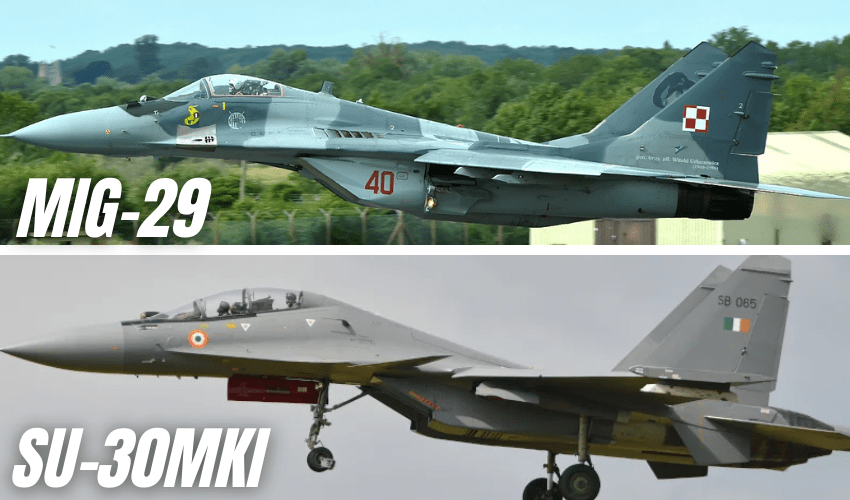The Indian Air Force is in the process of acquiring new Russian Su-30MKI and MiG-29 fighter jets. After gaining high praise for Mig-29 fighter jets from the Indian military, Moscow reacted to India’s MMRCA tender by pitching its MiG-35 fighter fighters.
According to Dmitry Shugaev of the Russian Federal Service for Military-Technical Cooperation, “the Russian side placed this jet [MiG-35] in the tender for the delivery of 110 medium fighter jets for the Indian Air Force.”
Following the purchase of 36 Rafale fighter jets, the Indian Air Force is looking to expand its fighter jet fleet.
The MiG-35s will compete against French Rafales, Eurofighter Typhoons, SAAB Gripen, US F-16, F-21, and F-18 Super Hornets, as well as Russian Sukhoi Su-35 fighters, in the MMRCA contract.
More MiGs and Sukhois will be on the way.
In addition to looking for new fighters, India will purchase 21 MiG-29 fighters and 12 Su-30 MKI aircraft from Russia. In the midst of the India-China border standoff last year, India’s Defense Acquisition Council authorised a plan to buy more Russian fighters and upgrade the 59 MiG-29 jets it already has.
According to Valeria Reshetnikova, a spokesperson for Russia’s Federal Service for Military-Technical Cooperation, Russia recently made a commercial offer to India to deliver 21 MiG-29 fighter jets.
Many experts questioned India’s decision to purchase MiG-29 fighter jets rather of the more modern Rafale fighter jets. Tom Cooper, an aviation specialist, questioned why the Indian air force preferred Su-30s and MiG-29s over Rafales fighters.
The Su-30, while formidable on paper, lacks performance and combat capability when compared to Rafale jets or even MiG-29 fighters, according to Cooper. He also reminds out that during the Kargil War in 1999 and the Balakot Airstrikes in 2019, the Sukhoi Su-30 fighters failed to make an impression, and India instead depended on the ageing Dassault Mirage-2000s.
India is impressed with the MiG-29 upgrades.
In an interview in 2019, Birender Singh Dhanoa, the then-chief of the Air Staff of the Indian Air Force, revealed that India had urged Russia to update Su-30MKI fighter jets deployed by the Indian military.
Dhanoa said in an interview with the Russian Armed Forces’ official publication, Krasnaya Zvezda, that New Delhi was pleased with the programme of modernisation of the Russian MiG-21, MiG-27, and MiG-29 fighters employed by the Indian Air Forces.
According to Dhanoa, these aircraft acquired contemporary weapons and avionics equipment as a result of the initiative, which had been successfully tested. Meanwhile, the Su-30 fighters have been in service in India for about two decades, and the military official revealed that New Delhi has asked Moscow to update the aircraft in accordance with current requirements.
What Makes MiG-29 Jets So Special?
The Indian Navy deployed roughly 20 MiG-29 fighters near the China border earlier this year, according to EurAsian Times, to boost its air force and oppose Chinese PLAAF jets.
The MiG-29Ks were meant to take off from the aircraft carrier Vikrant. India chose to dispatch its MiGs to reinforce the airforce against probable Chinese invasions because the carrier was behind schedule.
Despite engine reliability concerns, the MiG-29 appears to perform better in high altitudes than larger fighter planes as as Su-30MKIs, because to its 27-ton maximum weight. The MiG-29’s superior performance in difficult situations over the heavier Sukhoi fighters is no longer news.
Experts say that, like the Su-30s, the Su-33 and its Chinese equivalent, the J-15, are painfully slow. The Russian Navy is replacing its Su-33 fighters with the dependable MiG-29Ks, which are also used by the Indian Navy.
The MiG-29 is a powerful and efficient aircraft.
To confront the US F-15 Eagle and F-16 Falcon, the Soviet Air Force commissioned the first MiG-29 about 40 years ago.
It was a gorgeous and successful design that has been utilised by over 25 countries, including the United States (which was used for evaluation and testing purposes). India was the first country to purchase these magnificent planes as an export.
Despite the fact that the warplane’s airframe design is about half a decade old, it remains a formidable opponent for US jets. The MiG-29 fighters are known for their mobility, agility, and most significantly, reliability.
Unlike other updated variants such as the MiG-29SMT recently delivered to Syria or the MiG-29UPG on order from India (described as the most sophisticated MiG-29 variant), the fighter jet uses redesigned airframes with innovative composite materials and a notably different appearance.
The MiG-29M has a very capable twin-seat version, the MiG-29M2, that will be delivered as part of the purchase. Unlike prior twin-seat MiG-29 variants, the MiG-29M2 does not sacrifice sensor performance to accommodate an extra crew member, and it is geared for high-end combat rather than training.
The MiG-29M evolved from the MiG-29K, a carrier-based member of the aircraft family. The redesigned airframes were built from a lightweight Aluminum-lithium alloy with a harder and improved design to increase the thrust-to-weight ratio.
The geometry of the air intake ramps was changed, the upper intake louvres were removed to make room for more fuel in the LERXs, mesh screens were added to prevent foreign object damage (FOD), and the inlet dimensions were extended to allow for more airflow.
The Zhuk-ME pulse-Doppler airborne radar, as well as updated IRST systems, a helmet-mounted target designation system, and electronic countermeasures, are the main sensor enhancements. The new radar can detect air targets at distances of up to 120 kilometres, monitor ten targets while scanning them, and engage four targets at once.
The jet also features the new RD-33MK engine, which produces 7% more thrust than its predecessors. Its weaponry package for air-to-air combat comprises the R-77 and R-27 beyond visual range missiles, R-73 short-range missiles, and a 30mm Gsh-30-1 gun.
It can use the Kh-29, Kh-31, and Kh-35 missiles, as well as numerous precision-guided bombs, for air-to-surface missions.
